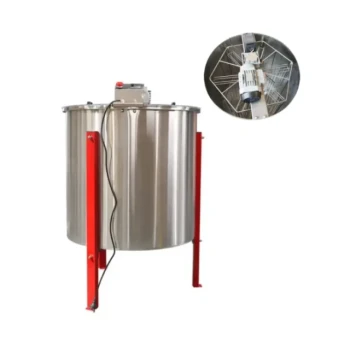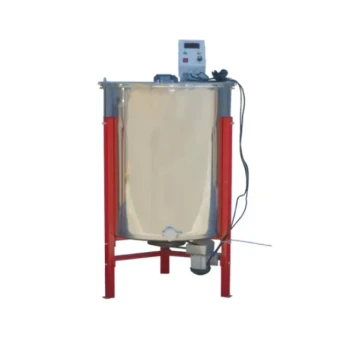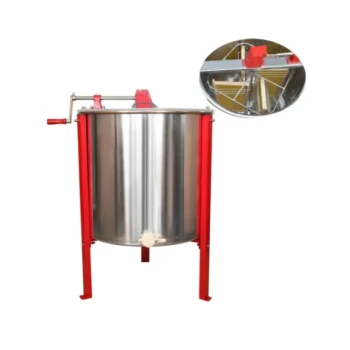When it's time to collect your honey, the process involves two primary stages: first, safely clearing the bees from the frames, and second, extracting the honey from the comb. The main methods for extraction are using a honey press (also known as the "crush and strain" method) or a mechanical honey extractor. A key tool for the preparatory stage is the bee escape board, which provides a gentle, chemical-free way to empty the honey supers of bees before you begin.
Your choice between a press and an extractor comes down to a fundamental trade-off: Do you want to preserve the honeycomb? A honey press destroys the comb to yield both honey and beeswax, while an extractor uses centrifugal force to remove the honey while leaving the valuable comb intact for the bees to reuse.
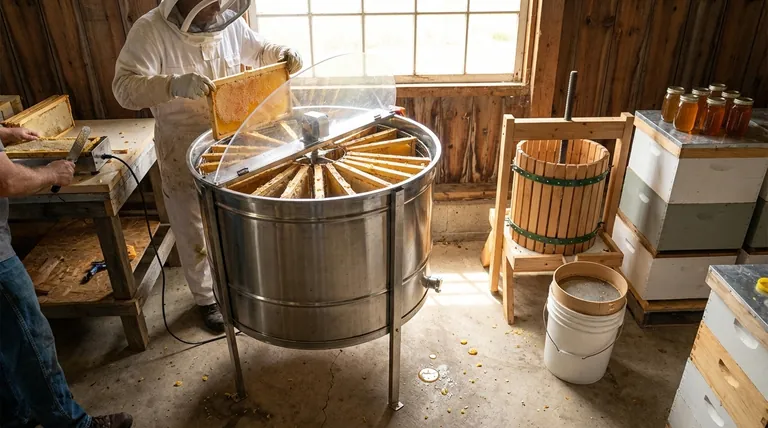
Preparing for Harvest: Clearing the Bees
Before you can harvest honey, you must remove the bees from the honey supers (the boxes containing the frames of honey). While brushing or blowing bees off is an option, it can be disruptive to the colony. A more passive and gentle method is preferred.
The Role of the Bee Escape Board
A bee escape board is a simple device that acts as a one-way door for your bees. It is the most common chemical-free method for clearing honey supers.
How It Works
You place this board between the honey supers you intend to harvest and the brood chambers below. The design allows bees to travel down into the main hive body but prevents them from getting back up into the supers.
Why This Method Is Recommended
This technique is calm and minimally stressful for the colony. After 24-48 hours, the honey supers will be almost entirely free of bees and ready for you to remove from the hive for harvesting. For those with multiple hives, using one escape board per hive allows you to prepare all of them for a single, efficient harvesting session.
Method 1: The Honey Press (Crush and Strain)
This is the oldest and most straightforward method of honey extraction. It is often referred to as the "crush and strain" method because that is precisely what you do.
The Fundamental Process
In this method, the entire honeycomb—wax and all—is scraped from the frames and crushed. The resulting mixture is then strained through a filter or cheesecloth to separate the liquid honey from the solid beeswax.
The Primary Outcome
The crush and strain method completely destroys the comb. Your final products are filtered, raw honey and a separate block of clean beeswax, which has many uses of its own.
When to Use a Press
This method is the standard for top-bar hives or hives using foundationless frames, as the comb in these hives is not reinforced with wire and cannot withstand the force of an extractor. It is also the best choice if your goal is to maximize your beeswax harvest.
Method 2: The Honey Extractor (Centrifugal Force)
Using a honey extractor is the most common method for beekeepers with standard Langstroth hives, especially those managing several colonies.
The Fundamental Process
First, the wax cappings on the honeycomb cells are sliced off with a heated knife or uncapping fork. The frames are then placed inside a large drum—the extractor—which spins them at high speed. Centrifugal force flings the honey out of the cells and onto the inner wall of the drum, where it drips down to a collection gate at the bottom.
The Key Advantage: Preserving Comb
The single greatest benefit of an extractor is that it leaves the drawn-out honeycomb intact. The empty frames can be returned to the hive for the bees to clean and refill immediately.
The Impact on the Colony
Bees expend a tremendous amount of energy and resources to build wax comb. It is estimated they consume 6-8 pounds of honey to produce just one pound of wax. By preserving the comb, you give your colony a massive head start on the next honey flow, leading to a much higher potential honey yield.
Understanding the Trade-offs
Choosing a method is not just about equipment; it's about aligning the process with your beekeeping philosophy, hive type, and goals.
Comb Preservation vs. Beeswax Harvest
This is the central decision. If you want to maximize honey production and reduce the workload on your bees, an extractor is superior. If you value a large beeswax harvest for making candles, balms, or other products, a press is the better choice.
Upfront Investment and Scale
The crush and strain method requires minimal investment—a bucket and a filter will suffice for a beginner. A honey press is a moderate investment. A honey extractor, however, is a significant piece of equipment, and its cost is best justified by beekeepers managing multiple hives where speed and efficiency are important.
Compatibility with Your Hive
Your hive type may make the decision for you. An extractor requires sturdy frames with foundation, typical of a Langstroth hive. A top-bar or Warre hive, which use foundationless comb, necessitates the crush and strain method.
Choosing the Right Method for Your Apiary
Ultimately, the best technique depends entirely on your specific situation.
- If you are a new beekeeper with one or two foundationless hives: The crush and strain method is a simple, low-cost, and effective way to harvest both honey and wax.
- If you manage multiple Langstroth hives and prioritize honey yield: Investing in a honey extractor is the most efficient choice, as preserving the drawn comb will significantly boost your colony's productivity.
- If you have a top-bar hive or your primary goal is a large beeswax harvest: A honey press or the simple crush and strain method is perfectly suited to your needs.
Understanding these core harvesting methods allows you to choose the process that best supports the health of your colony and your personal beekeeping goals.
Summary Table:
| Method | Best For | Key Outcome | Primary Consideration |
|---|---|---|---|
| Honey Press (Crush & Strain) | Top-bar hives, foundationless frames, beekeepers prioritizing beeswax harvest | Destroys comb; yields honey and beeswax | Lower upfront cost; ideal for smaller-scale operations |
| Honey Extractor | Langstroth hives, multiple colonies, beekeepers prioritizing honey yield | Preserves comb for bees to reuse; yields honey only | Higher efficiency; preserves bee energy for higher honey production |
Ready to optimize your honey harvest?
At HONESTBEE, we supply commercial apiaries and beekeeping equipment distributors with the high-quality tools needed for efficient, large-scale operations. Whether you're scaling up and need reliable honey extractors or require durable equipment for any harvesting method, our wholesale-focused operations are designed to support your business's growth and productivity.
Contact our team today to discuss your specific needs and explore our range of beekeeping supplies.
Visual Guide
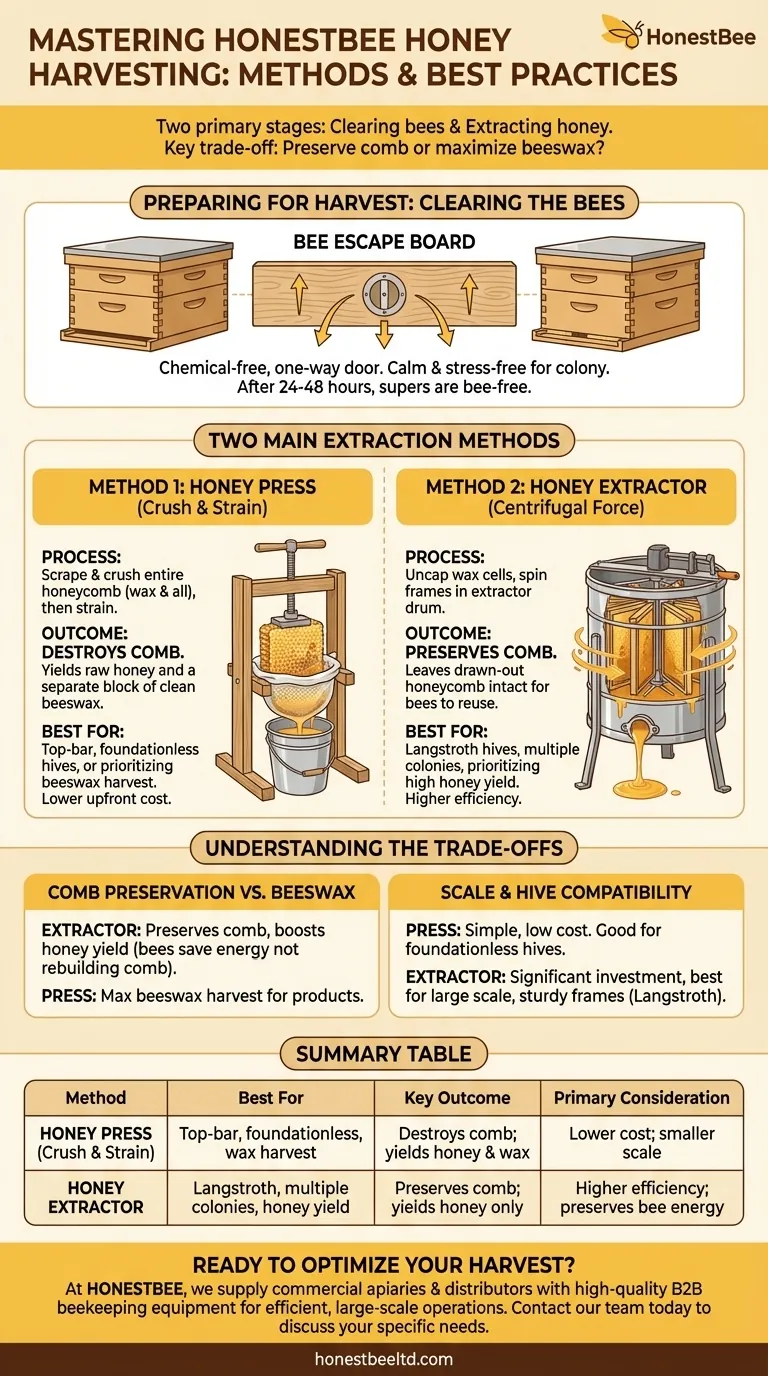
Related Products
- HONESTBEE 72 Frame Industrial Electric Honey Extractor for Beekeeping
- HONESTBEE 3-Frame Manual Acrylic Honey Extractor
- Stainless Steel Manual 8 Frame Radial Honey Extractor Machine for Beehives
- 8-Frame Electric Self-Reversing Honey Extractor Spinner for Commercial Honey Extraction Equipment
- Electric 8 Frame Honey Spinner Extractor Equipment for Beekeeping
People Also Ask
- How is honey harvested from Langstroth hives? A Guide to Efficient, Comb-Preserving Extraction
- How do automatic honey extractors function? Achieve High-Efficiency Honey Harvesting
- What are the advantages of automatic honey extractors? Scale Your Apiary with Unmatched Efficiency
- Why is preserving honeycomb integrity important, and how do automated extractors help? Boost Hive Health & Honey Yields
- What are the advantages of automated honey extractors in terms of time efficiency? Boost Your Harvest Speed






